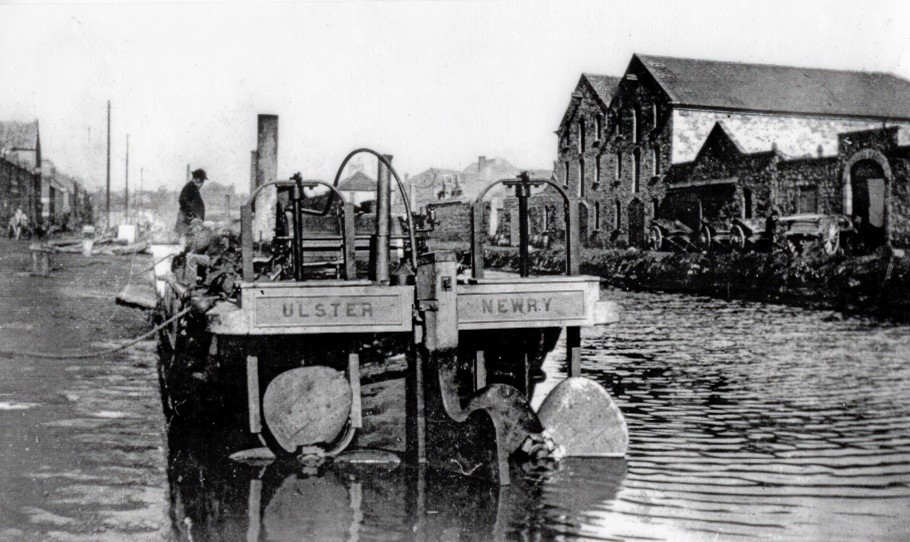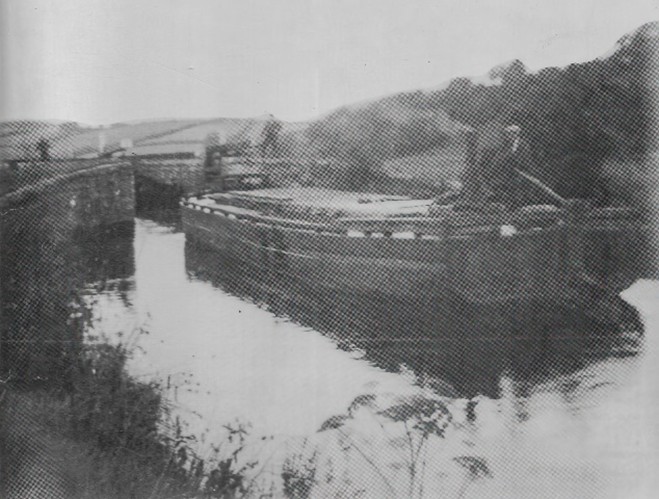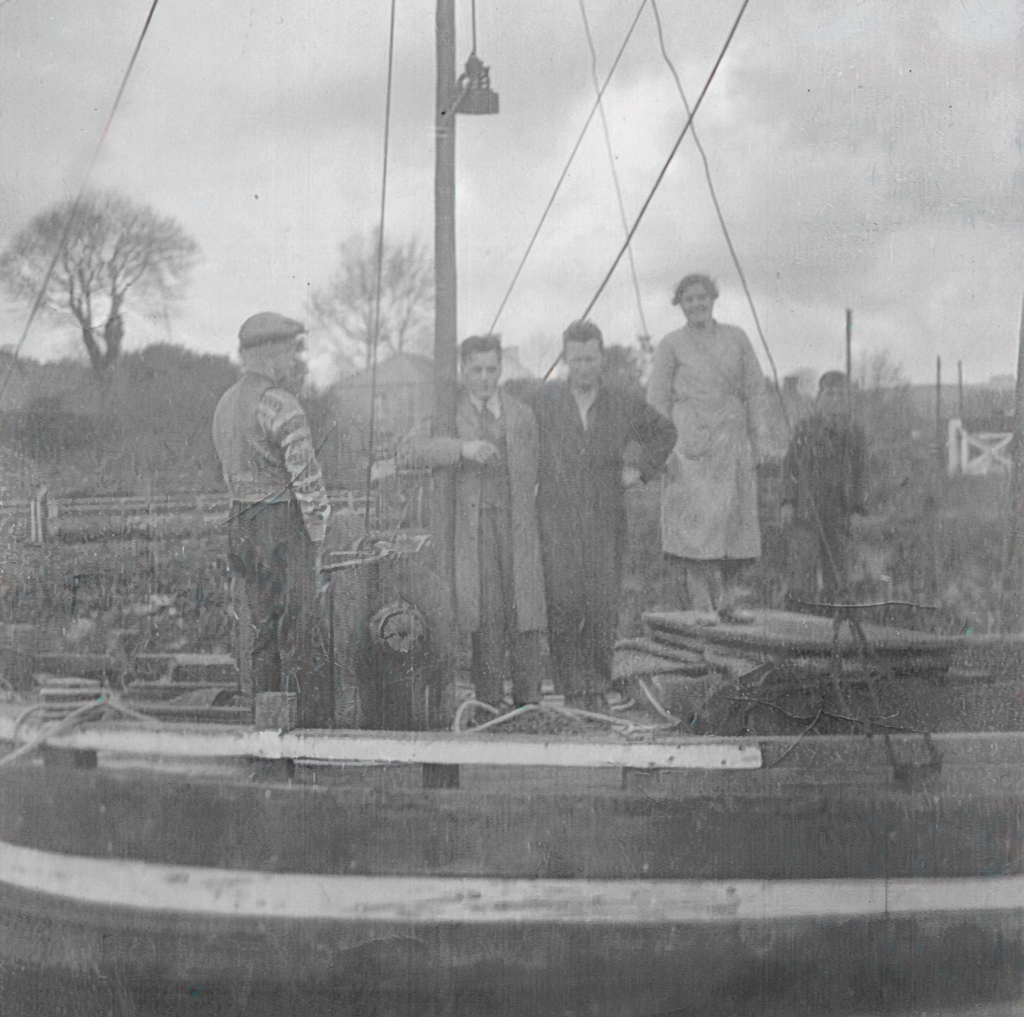By the 1850s, the new railway, which ran parallel to the canal, had become a major threat to its continued prosperity.
Various attempts were made to bring trade back to the canal from the railways, but ultimately all were in vain.
The Decline Begins
The long, protracted decline of canal traffic and revenues began, of course, with the completion of the D&BJR in the early 1850s.
Like the canal, the railway needed a largely flat route through drumlin country, and so it naturally followed the same route for much of its length. Two modes of transport existed side by side – one fast, and one very sedate, and for anyone travelling on either, the comparison was very obvious.
So, the canal became largely confined to carrying heavy bulk cargoes, such as coal and grain, but even these slowly declined as the railways developed appropriate rolling stock and handling techniques.
Canal toll receipts had peaked in the 1790s, about 50 years after it opened, when they reached about £7,000 a year. After that it was a case of slow, if not steady, decline. They dropped to about £2,000 in the 1820s and rose again to about £4,000 in the early 1840s, but by the early 1860s they dropped to £1,000 for the first time in over a century, and stubbornly stayed there until the late 1920s, dropping to zero in the 1930s.
Attempts to compete with the railways, even by coordinating and integrating services with them, ultimately failed. In September 1860, adverts appeared for an auction to be held in Newry; top of the bill was the steamboat ‘The Countess of Caledon’ with which Dargan had, since 1842, run a daily service from Portadown, across Lough Neagh to Ballyronan, about 5 miles from Magherafelt. But there were also 26 canal lighters for sale; that large number gives some idea of the very steep decline in traffic.
There were many attempts to revitalise the canal during its long lifetime, many injections of capital to repair it, and many changes in who was responsible for managing it, swinging to and fro from centralised control to management by local interests, and back again.
Attempts were also made to introduce new technology and services – below- but in the end, none of it worked.
Steam Power
In 1850, it was reported that in Dublin, a Mr O’Regan was experimenting with the application of stem power to canal lighters, and that William Dargan had attended the trials in Dublin at the end of October.
“It consists in the application of steam, as a motive power, to lighters on canals; the result of which will be, to expedite the transit of heavy merchandize, and decrease the cost of its carriage…some experiments made on the Newry canal last week, proved that lighters unloaded may attain the speed of four miles an hour, and loaded, say to the amount of 30 tonnes, between three and four miles in the same time…We understand that Mr Dargan has already fitted up the lighter with the requisite machinery, and…intends to have eight lighters similarly adapted for the purpose of plying on the Newry Canal.”
During August and September 1853, the following advert appeared in various newspapers:
“IMPORTANT TO The Merchants and Manufacturers of Banbridge, Gilford, Moyallen, Scarva &c., On and after the 1st September next, the ULSTER CANAL STEAM CARRYING COMPANY with the view of giving every facility to the Merchants and Manufacturers in the above districts, and affording a quick and cheap transit for their goods to and from Liverpool, has determined on running a Small Screw Steamer from Madden-Bridge and Scarva (on the Newry Canal), in conjunction with their splendid and powerful Steamers the Sea Nymph and the Eagle, which ply regularly between Newry (sailing from Warrenpoint Dock) and Liverpool (sailing from the Collingwood Dock) on Tuesdays, Thursdays, and Saturdays, until further notice.”
The company was formed in 1838 and bought in 1842 by the ubiquitous William Dargan. He greatly expanded its facilities, building more warehouses and greatly expanding its services. It also had a fleet of steamboats on Lough Neagh which towed lighters between the mouths of the Newry, Ulster and Erne canals, thereby greatly speeding up part of a journey which had previously relied on sail.
But steam power never really took hold on the Newry Canal.
Fly Boats
In 1830, an employee of a Scottish canal discovered by accident that a horse could pull a canal boat at a much faster pace, up to 10mph, over long distances with very little more effort that at the usual walking pace when the boat being pulled started to aquaplane on its own bow wave.
Fly boats utilised this discovery, and were more streamlined, smaller, canal craft which ran to a regular schedule, had enough crew on board not to need to moor overnight, and (if the company running the service also owned the canal or had an arrangement with the owners) could take priority and skip any queue at a lock.
The Ulster Canal Steam-Carrying Company ran fly boat services on the Ulster and Newry canals during the 1840s.
Barcroft’s Semi-Immersed Propellor
As Irish canals became more and more badly maintained and choked with weeds because of shrinking revenues, Newry inventor Henry Barcroft tried to overcome the problem of weeds fouling small fast-rotating screw propellors on steam-powered lighters and came up with his huge eponymous Barcroft Semi-Immersed Propellor, which, along with a small steam engine to power it, could be easily retro-fitted to an existing lighter.

Several Irish lighters were fitted with them in the 1890s, including the ‘Ulster’ based in Newry. Barcroft’s propellers may have solved the weed problem but were very inefficient and took a heavy toll on the machinery that drove them. One 1950s commentator described them as supplying “…a maximum of splash for a minimum of speed”.

This image, from the front cover of BIF Vol 7 (1990) shows a lighter near Jerrettspass ca. 1935. Despite the chimney, it isn’t steam-powered. Mick Waddell states in BIF Vol 4 (1990) that in the 1920s the lighters were all pulled by horses.
Some small investments were still being made in keeping the canal operational; in October 1929, Newry Harbour Board ordered new gates for the Poyntzpass lock, saying “The present gates, which were constructed 48 years ago, are very frail and might give way at any time.”
Death Throes
In August 1932, Fisher & Sons of Newry complained to the Newry Port & Harbour Trust that one of their lighters, the Nora[1], was unable to reach Portadown with an urgent cargo of coal because the canal was choked with weeds at Poyntzpass. The Trust’s engineer was very unapologetic – he said that the weeds had appeared a month earlier than usual, and that a lot depended on the quality of the horses the lightermen used!
The same problem surfaced a year later, when in October 1933, the Provincial Coal Company complained about low water levels and demanded a refund as they had to employ an extra horse to pull their lighters through dense weeds between Poyntzpass and Tandragee. The Board was again unsympathetic, stating that they could not make rain!
In July 1933, the Newry Harbour Trust’s engineer reported that the bridge over the canal at Drumbanagher was in a highly dangerous state, and that he had complained to the County Surveyor.
In November 1934, Newry coal importers wrote to the Port & Harbour Trust saying that unless tolls on the canal were further reduced, they would immediately cease using the canal and switch to road transport.
The canal was in its death throes; the inland section north of Newry closed[2] to commercial traffic in 1936 and on 7th May 1949 a warrant was issued for the formal abandonment of the canal.

This image, taken sometime in the mid-1930s, shows my father, Henry Clarke (holding mast) and his sister Isa on board one of the last lighters on the canal, moored at Poyntzpass Harbour. The school and the railway gates can be seen in the background.
The Canal Becomes Unnavigable
The final blow came in November 1950, when Armagh County Council approved the replacement of the hump-backed bridge at Poyntzpass with a flat, reinforced-concrete one at a cost of £3,000. This work was carried out in 1951, and soon afterwards, Gamble’s Bridge at Drumbanagher was similarly replaced.
The lock gates or sluices were left permanently open, the water level dropped to just a trickle, and the inland canal became unnavigable except by the very smallest of boats; even these had to be portaged round the locks.
It was a sad end for the first canal built in the British Isles since Roman times.
Newry Bridges Replaced
In Newry, four wooden swing bridges still existed, to allow now-non-existent lighter traffic to pass through the town. In January 1955, the Frontier Sentinel carried the headline “ABOLISH THE BRIDGES” and calling for permanent solid bridges. The Monaghan Street bridge had only been built in 1930 at a cost of £12,000 but was troublesome from the start. It was driven by an electric motor, but this drew so much power that nearby residents claimed that when it was used, and their lights were on, the lightbulbs exploded! The replacement of the old swing bridges by conventional concrete bridges began in 1956.
Even after abandonment, the inland canal remained important in keeping the port of Newry operating. Along with the Camlough River, it was still a major source of water for the ship canal between Newry docks and the sea. Every time a ship entered the sea lock at Fathom, roughly half a million gallons (well over 2,000 tons) of water was lost and had to be replaced, to maintain the safe depth of the ship canal. Locks on the inland canal were left open, and it became silted and choked with weeds, so it no longer functioned as a huge ‘header tank’ for the ship canal.
Final Legacy
In 1980, Enterprise Ulster published a £2m plan to restore the canal and make it navigable for tourist and leisure use, but nothing came of it or of subsequent proposals.
Perhaps the single positive legacy of the closure of the inland canal has been the establishment of a walking and cycling route called The Newry Canal Way along most of the length of the towpath. The interpretation centres at Scarva and Lough Shark were created in 1993.
[1] See “The Last Voyage of The Nora” by Frank Watters, BIF Vol 13, 2015. The Nora’s anchor is on display beside the bridge and information board.
[2] Had all of the lockkeepers been employed until that date? Did they then lose their jobs? … and houses?